
Anacamptis is a genus of flowering plants in the orchid family (Orchidaceae); it is often abbreviated as Ant in horticulture. This genus was established by Louis Claude Richard in 1817; the type species is the pyramidal orchid and it nowadays contains about one-third of the species placed in the "wastebin genus" Orchis before this was split up at the end of the 20th century, among them many that are of hybrid origin. The genus' scientific name is derived from the Greek word anakamptein, meaning "to bend backwards".
Tongue orchid or tongue-orchid is a common name for several plants and may refer to:

Saint Sabina, matron and martyr from Rome.
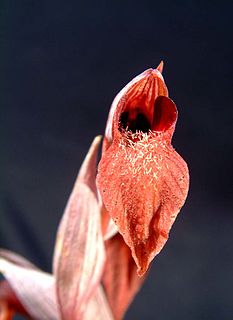
Serapias is a genus of terrestrial orchids that can be found all over southern Europe to Asia Minor. The genus was named after Serapis, a syncretic Hellenistic-Egyptian god in Antiquity. Serapias have spurless flowers and usually go dormant during the winter seasons.

Serapia was a Roman saint, a slave and martyr, also called Seraphia or Seraphima of Syria.
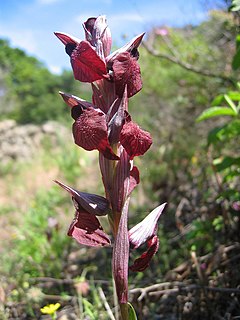
Serapias cordigera is a species of orchids found from the Azores, south-central Europe to the Mediterranean.
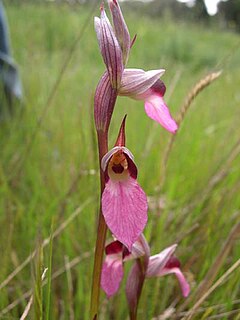
Serapias lingua, commonly known as tongue-orchid or the tongue Serapias, is a species of orchid native to the Mediterranean.

Serapias perez-chiscanoi is a species of orchid endemic to western Portugal and western Spain.

Serapias neglecta, the scarce tongue-orchid, is a species of orchid endemic to southern Europe.

Serapias orientalis is a species of orchids occurring from the east-central and eastern Mediterranean to the western Transcaucasus.
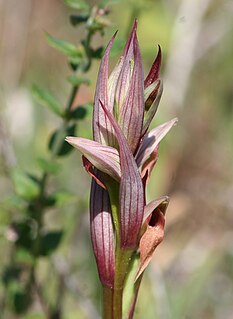
Serapias parviflora, the small-flowered tongue-orchid, is a species of orchid native to the Mediterranean Basin and the Atlantic coast of Europe.
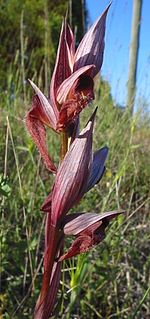
Serapias vomeracea, common name long-lipped serapias or the plow-share serapias, is a species of orchid in the genus Serapias.

The Bednja is a river in northern Croatia, a right tributary of the Drava. It is 133 kilometres (83 mi) long and its basin covers an area of 966 square kilometres (373 sq mi). The Bednja rises in the mountainous forested areas near Macelj in northern Croatia, west of Trakošćan, where it also forms a 0.2 km2 (0.077 sq mi) lake at 255 m.a.s.l. It flows towards the southeast until turning east near Bednja, meandering south at Novi Marof, returning to its eastward course shortly thereafter, and then turning northeast toward Ludbreg. It flows into the Drava River north of Mali Bukovec, at 46.303333°N 16.756389°E.

Serapias stenopetala is an orchid plant that is in the genus Serapias. The common name of the plant is sérapias à pétales étroits in French. The plant is endemic to Algeria, and Tunisia.
Parapithecidae is an extinct family of primates which lived in the Eocene and Oligocene periods in Egypt. Eocene fossils from Myanmar are sometimes included in the family in addition. They showed certain similarities in dentition to Condylarthra, but had short faces and jaws shaped like those of tarsiers. They are part of the superfamily Parapithecoidea, perhaps equally related to Ceboidea and Cercopithecoidea plus Hominoidea - but the placement of Parapithecoidea is substantially uncertain.
Lonchitis is a neotropical genus of ferns. It is the sole genus in the family Lonchitidaceae. At one time Lonchitis was placed in the Dennstaedtiaceae, and then transferred to the Lindsaeaceae, before being placed in its own family.

Orthetrum serapia, the green skimmer, is a freshwater dragonfly in the family Libellulidae. The serapia species is present in Australia, the Philippines, Fiji, Papua New Guinea and Solomon Islands. It inhabits a wide range of still and sluggish waters, often shallow. In Australia it ranges from the top end of the Northern Territory to about Mackay in central Queensland.
Orchideae is a tribe of orchids in the subfamily Orchidoideae. It has been divided into two subtribes, Orchidinae and Habenariinae. The subtribe Orchidinae alone contains about 1,800 species. However, although some phylogenetic studies have established the monophyly of the subtribes, the generic boundaries are unclear, with many genera as traditionally circumscribed being paraphyletic or even polyphyletic. Species of genera such as Habenaria and Platanthera have been placed into both subtribes. A 2017 molecular phylogenetic study found that both subtribes did form clades, but did not formally recognize Habenariinae, because of missing genera and uncertainty over generic boundaries. The Asian species of Orchideae, in particular, have been subject to repeated changes of generic placement from 2012 onwards.
Proteopithecidae is an extinct family of primates which lived in the Priabonian and probably early Oligocene periods. Fossils that have been found are in the Jebel Qatrani Formation in Egypt. Currently two genera are recognised, each with a single species, those being Proteopithecus sylviae and Serapia eocaena.

Landscape with the Burial of St. Serapia is a 1639–40 painting by Claude Lorrain, one of several commissioned from the artist by Philip IV of Spain and now in the Prado Museum. it shows the burial of Saint Serapia, slave to Saint Sabina – the lid of the sarcophagus is shown with the inscription SEPVLTVRA.S.SABIN (a)... SEPELIR(e) IVBET.C.SANCTAE SERAPI(ae). Her martyrdom occurred in Vindena, now known to have been sited near Terni, although at the time the painting was produced it was thought to be located on the Aventine Hill.














